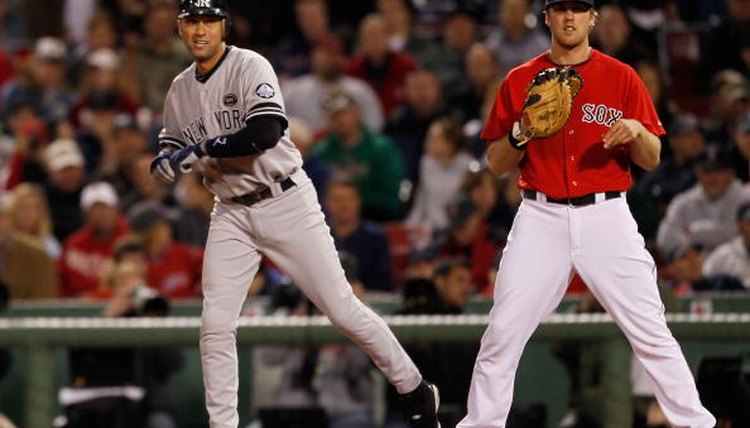What Position Can Left-Handed Baseball Players Play?

Left-handed players are often at a premium in baseball. A manager or coach wants high-quality left-handed pitchers and power hitters, yet there are relatively few positions for left-handed players to occupy on the field. There are no rules against lefties occupying certain positions, but tradition and practicality limit the positions they can play.
Pitcher
Baseball general managers, managers, coaches and scouts have no hesitation when it comes to having left-handed players on the pitcher's mound. Left-handed pitchers who throw hard and can find the plate are among the most valued players in baseball. Sandy Koufax, Whitey Ford, Warren Spahn, Carl Hubbell, Steve Carlton and Randy Johnson rank at the top of the left-handed pitchers' list. One of the reasons left-handed pitchers are so valuable is that the large majority of pitchers are right-handed. Hitters have a hard time getting used to looking at a pitch coming from a left-hander. When a left-handed pitcher throws a curveball or slider, it can be difficult for hitters to pick up.
First Base
First base is the only position where having a left-handed player is preferred. The left-handed first baseman's glove is on his right hand and that puts him closer to the fielders when a ball is thrown. It also gives him a better angle when it comes to stretching for the ball and picking up errant throws in the dirt. When an opponent bunts, the left-handed first baseman can pick up the ball and step directly toward second or third base to make a throw. Right-handed first basemen must spin around to make those throws.
Outfield
Left-handed players have equal status with right-handers in the outfield. A left-handed left fielder has an advantage on a ball hit down the left-field foul line, much the same way a right-handed right fielder has an advantage on balls hit down the right-field foul line. In both cases, the gloved hand is closer to the foul line and that should give those players a better chance to make tough fielding plays down the line. However, those advantages are small. Left-handers can play any of the three outfield position and should not have a problem.
Infield and Catcher
Baseball administrators and coaches almost never give left-handed players a chance to play second base, shortstop, third base or catcher. Left-handers have a clear disadvantage at those positions. After fielding a ground ball, the left-handers must spin their body around to make the throw to first base. While there is no reason left-handers can't do this and still make accurate throws, right-handers do not have to go through this procedure and it gives them an advantage. There is no logical reason left-handers cannot play catcher. Right-handed players would appear to have a small advantage because the majority of the hitters are right-handed. When there is a right-handed hitter in the batter's box, the left-handed catcher would have to throw over the top of the batter when attempting to throw out a runner who is stealing second or third base. Left-handed catchers in Major League Baseball have been rare. Benny Distefano of the Pittsburgh Pirates caught three games in 1989 and was the last left-handed catcher to play the position going into the 2011 season.
References
Writer Bio
Steve Silverman is an award-winning writer, covering sports since 1980. Silverman authored The Minnesota Vikings: The Good, The Bad and The Ugly and Who's Better, Who's Best in Football -- The Top 60 Players of All-Time, among others, and placed in the Pro Football Writers of America awards three times. Silverman holds a Master of Science in journalism from the Medill School of Journalism.
